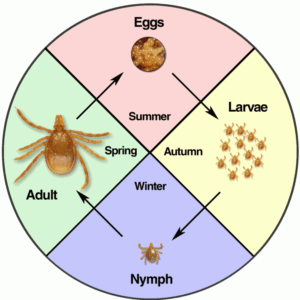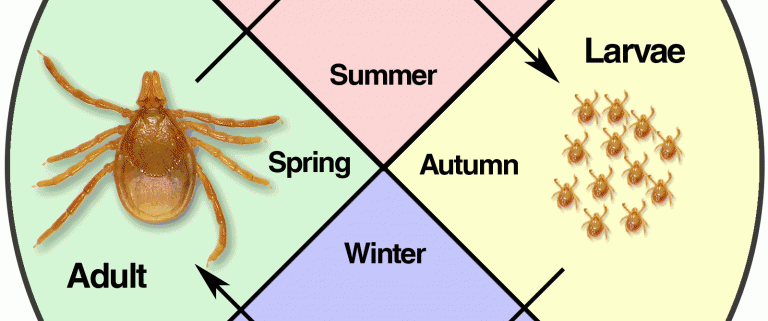Ticked off

by Angela Marshall
In the September issue of The Triangle, I wrote an article about paralysis ticks (Ixodes holocyclus). I was staggered by the amount of feedback and interest that this sparked. There is genuine interest in all things tick. I need to make something clear – I am not a health or veterinary professional. If you find a tick on a human or a pet and are worried, please consult your GP or vet.
My interest in acquiring and distributing information on the local ticks is because I have both tick allergy and MMA (aka Alpha-gal Syndrome, AGS) – two compelling reasons to avoid being bitten.
Please note that different ticks have different requirements (much of the online information concerns ticks from around the world, particularly the US) so this only applies to Australian paralysis ticks.
The villain
It falls to me to provide the counterweight to the general tone of October’s spring positivity – the flip side to all that sap rising, flowering, burgeoning optimism of the new season. Because this is also the time of year that residents of the Triangle region (and, in truth, all along the eastern seaboard) need to remember the bloodsucking reality of living within twenty kilometres of the coast in a region of forests and treefern-dominated understoreys with abundant wildlife …
Boom tish, I present to you, Ixodes holocyclus, aka the paralysis tick.
This tick is present throughout the year in one of its many phases but spring heralds the presence of this year’s population of adult female ticks ‘questing’ for a blood meal before laying eggs. The dominant hosts of paralysis ticks are bandicoots, but ticks have broad tastes and will also accept wallabies, ’roos, possums and other native animals (who are all relatively immune to their toxins). They also feed on livestock, such as sheep, horses and cattle, our pets (cats, rabbits and dogs etc) and humans.
Tick life cycle
Paralysis ticks have a three-host life cycle and they require a host to provide a protein-rich blood meal for each phase of that life cycle from larvae to nymphs to adults and, for the female, a final feed before laying eggs.
The period from September to mid-summer is the usual peak season for egg laying but this is also affected by temperature and moisture. Ticks are happiest in warm (but not hot) weather, that is consistently moist. The last three years here have seen nearly perfect conditions for ticks to thrive. The prevalence of ticks in any particular season reflects the conditions during the previous year as the tick life cycle takes approximately a year to complete.
For the most part, paralysis ticks live in long grass and on low, shrubby vegetation, especially in areas that are frequented by bandicoots, wallabies and other critters. They have sensory organs on their front legs that they wave about as they sit on a twig or leaf (a behaviour called questing) and can detect CO2 (exhaled breath), body heat and odours, and possibly even variations in light and vibrations. They usually transfer to a host as it brushes past them. They are not an ambush predator, and they are not high in trees unless they’ve been transported there (possums, koalas?).
So here we are, looking at another season of abundant ticks and it is important that we are alert to the dangers of being bitten by the blighters. If you are bushwalking, camping and gardening, you need to wear light, loose clothing and a hat, closed shoes and socks. Try to have as little exposed skin as possible. I strongly recommend spraying your clothing, including hats and shoes, with a strong tick repellent, preferably containing DEET (and respray every few hours). In my experience the milder repellents and those based on herbal concoctions do not work sufficiently well.
Possible consequences of tick bite
The more often you are bitten by an adult tick, the more likely you are to be badly affected by them. There are several pathways to harm.
Humans can have two different allergic reactions. One is immediate – the tick bites you and alpha-gal (a component of tick saliva) is injected into you in the tick’s saliva and you can have a serious allergic reaction that can culminate in anaphylactic shock.
The second is tick-induced mammalian meat allergy (MMA). MMA is an ongoing allergic reaction to mammalian meats. This is not the result of an individual tick bite but is caused by a history of tick bites. The first time you are aware that you are having an allergic reaction it doesn’t occur within minutes of a meat meal but four to eight hours later. This can make it difficult to join the dots.
Paralysis ticks also have specific neurotoxins that disrupt nerve function leading to muscle weakness and eventually paralysis – this is usually seen in animals and small children rather than adult humans as the tick must remain attached for four or five days before sufficient toxins are delivered. The reaction to the toxin is dose related and the smaller the host, the quicker and more severe the reaction.
A fourth pathway to harm is that you may be affected by pathogens that are on and around the tick’s mouth parts. The bite site can be contaminated by a range of pathogens (viruses, bacteria and even fungi). In Australia, this can include the Ricketsia group of bacteria that are responsible for spotted fever and Queensland tick typhus.
All this sounds pretty alarming but, again, the tick must be attached for at least a day or more to transmit these pathogens so awareness of the possibility of ticks and their prompt removal are essential. Examine yourself, children’s bodies and your pets daily after being in the garden or bush.
Removing a tick – freeze, don’t squeeze!
There are many incorrect ways to remove a tick – NEVER use methylated spirits, nail polish, teatree or eucalyptus oil (or any essential oils), kerosene, alcohol, a lighted match or any other irritants. Once the tick realises that you are onto them, they can inject more saliva, gut contents and toxins.
For adult ticks, the best method is to apply an ether-based spray (sold in pharmacies as wart or skin tag remover) that will freeze them almost instantly. For smaller larval or nymph ticks, gently smear permethrin-based scabies cream (Lyclear) on them and apply a band-aid for a few hours. Once dead, they should fall out (or can be removed).
If you insist on pulling them out, do not use normal tweezers – these are too bulky and run the risk of squeezing the body of the tick and causing it to inject more saliva and gut contents into the blood stream making the bite much more harmful. There are specific tick removal tweezers, but you need a very steady hand and good eyesight to grasp the tick firmly and quickly behind its mouth part and below its abdomen then, slowly and smoothly, pull it out without jerking or twisting. The mouthparts that are buried in the skin have reverse barbs making them difficult to remove while they are still alive.
Pets
Domestic pets can also be disastrously affected by paralysis ticks. Dogs are the most commonly affected because they run around in long grass or in and under shrubs where ticks are hanging out waiting for their next blood meal. Closely examine your dogs every day even if you have them on tick preventative medication (your finger tips are better at detecting ticks than your eyes are). These days there is a large range of tick repellents for dogs and cats – some are edible, some are in impregnated collars, many even kill ticks, some are very long-lasting, others need to be reapplied frequently. Discuss the best products for your pet with your vet.
Essential oils as repellents
Many people want to avoid using ‘chemical’ protection against ticks. Essential oils are regularly suggested as a natural alternative. This is a false dichotomy as essential oils are potent sources of an enormous range of chemicals, some of which merit serious caveats. Depending on the essential oil, they can cause skin irritations, lung sensitivities, some are even hormone disruptors and others have neurotoxic effects. They must be heavily diluted and not used on animals, young children, elderly or unwell people. Their efficacy as deterrents is not high enough for me as I must avoid being bitten.
Fun facts about ticks
- Australia punches above its weight with over 70 species of tick, only 17 of which bite humans.
- The paralysis tick has many names that apply to the various stages of the tick life cycle and create confusion as many people think these are different species. The larval stage is known as shower or seed ticks; nymphs are often called grass ticks; and adults can be called shellback, hardback, bottle or bluebottle ticks. Historically, pioneers in the Illawarra named them wattle ticks. But they are all Ixodes holocyclus.
- Larval and nymph ticks of both sexes bite and can cause a very itchy localised reaction to the bite, especially if you are unlucky enough to have many tiny ticks attach.
- The adult females need to have a blood feed before laying their eggs. Adult males do not feed directly from a host but, if they encounter an engorged female, they will sometimes pierce her blood-filled abdomen and help themselves.
- Those who are allergic to the tick itself should be very careful handling ticks – wear latex gloves to avoid triggering anaphylaxis.
- Tick-induced mammalian meat allergy (MMA) is an acquired allergy that was discovered by Australian scientists in 2002. It can be confirmed by specific blood tests ordered by a GP or immunologist. It is quite simple to avoid all mammal meat products if you are preparing your own food but a bit trickier when you are eating out or travelling. The allergy is not just to obvious foods like a steak or a chop, people with MMA must avoid a lot of ‘hidden’ ingredients like gelatine, many thickeners, stocks, sausage casings, Bonox, Bovril etc (but Vegemite is fine!). Mammal meat obviously includes beef, mutton, lamb and pork but also includes guinea pigs and whales. People with MMA can feast on all poultry, reptiles
and seafood. - MMA has been reported in 17 countries and six continents but occurs mainly in Australia and the US. It is the first known food allergy that has a delayed onset of several hours after eating the allergen, and the first that is an allergy to a carbohydrate (alpha-gal) rather than a protein.
This article is compiled from articles published in the September and October issues of The Triangle.


